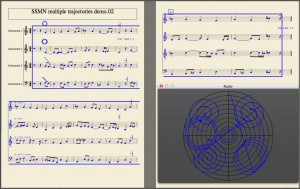SSMN Blog 2012_09_26
History.
In 2004 Giorgio Zoia of the DSP division invited Emile Ellberger to the EPFL to create content for the WFS system. As Emile had the opportunity to work on a musical composition for an installation that lent itself to be spatialized, he entered audio and spatialization data into the system. In view of the cumbersomeness of the procedure, he imagined the idea of creating a library of spatialization symbols as part of a plug-in available in DAWs as well as score editors. At an Ambisonic workshop in Stuttgart (2007) he proposed his idea to members of the ICST Zürich team and began a feasability study with Johannes Schuett, composer and Ambisonic specialist, under the auspices of Gerald Bennett, founder and former director of ICST on this project named “SSMN- Spatialization Symbolic Music Notation”. Consequently our research team expanded and now consists of Germán Toro-Perez- present director of ICST, Johannes Schuett, Kaspar Moessinger- IT specialist, Linda Cavaliero- designer, Giorgio Zoia- who take on the role of project advisor, two practice partners- Vincent Gillioz, film composer in Los Angeles and Editions Papillons and Emile who is the team leader. We are presently underwritten by the Swiss National Fund (SNF) and are associated with the ZHDK (University of the Arts of Zurich).
State of the research.
The goal set for the present project consists of establishing a “taxonomy” of spatialization possibilities, designing a library of basic symbols to be included in a score editor, developing spatialization notation features (parameters & visualization) in an open source score editor (“MuseScore”), creating and developing a rendering engine so as to be able to hear the spatialized results on speakers or headphones. Our primary target users are composers, performers (instrumentalists), and concert tonmeisters. A first draft of the Taxonomy was established by Germán and Emile. An basic idea for the practical application of SSMN includes playing a score introduced into MuseScore with MIDI data transported to a soft sample player, the output of which is spatialized using Ambisonic encoding and decoding algorithms. As MuseScore is under constant development, we were unhappily confronted with non-functioning parameters, in particular the JACK-MIDI transmission possibilities. Kaspar ultimately resolved this issue. Nonetheless, MuseSore 2.0, being unstable, we find that testing results remains quite a challenge. As for the spatialization symbols, after various attemps, it was decided to use the “Inspector” paradigm to introduce parameters. and Kaspar included a graphic radar into the software which allows visualisation of the position and/or trajectory of each symbol placed in the score. Johannes has created several SSMN players and is aiming for clarity and simplicity in the user interface. He is writing scripts that will automate the installation procedures and facilitate working with the entire SSMN package. Linda, having submitted numerous design possibilities and strategies for indicating spatial activity, is also in charge of the SSMN logo and blog design.
Recent activities
(Grimentz 11-18 september 2012)
Four members of the SSMN team (Johannes&Emile-8 days, joined by Linda&Kaspar-5 days) participated at a workshop at which a 7.1 speaker set-up allowed for testing spatialization possibilities of the SSMN rendering system and priorities were set up in view of the October 6th meeting with composers in Zurich.

